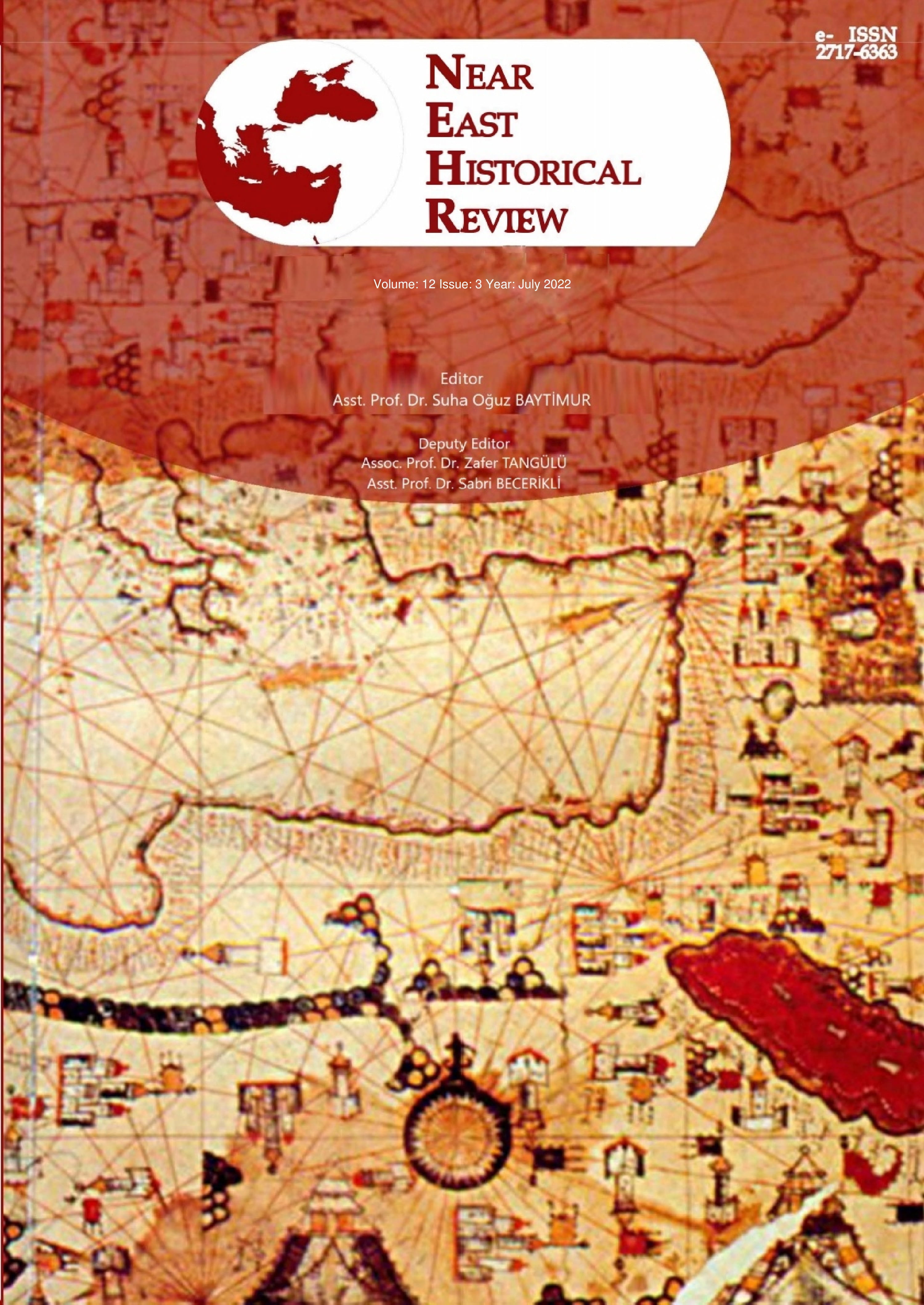Author :
Abstract
30 Ekim 1918 tarihinde Mondros Mütarekesi imzalanmıştır. Ardından Anadolu’nun çeşitli bölgeleri işgal edilmiştir. Milli Mücadele’nin ilk adımı 19 Mayıs 1919 tarihinde Mustafa Kemal Paşa’nın Samsun’a çıkmasıyla başlamıştır. Anadolu’da çeşitli kongreler yapılmıştır. 2. Süvari Grubu ise 29 Aralık 1920 tarihinde Güney Cephesi Komutanlığı emrinde kurulmuştur. 2. Süvari Grubu, tümen yetkisinde olduğu için daha sonra 2. Süvari Tümeni adını almış ve üç süvari alayından meydana gelmiştir. 2. Süvari Tümen Komutanlığı’na ise Binbaşı Hüseyin Rahmi Bey (Apak) atanmıştır. 2. Süvari Tümeni, iç isyanların bastırılmasında etkin rol oynamıştır. Tümen, 1921 yılı içerisinde gerçekleştirilen I. İnönü, II. İnönü, Kütahya-Eskişehir, Sakarya Meydan Muharebeleri dönemlerinde 1., 2., 4., 12. 5. Gruplara bağlanmıştır. 1922 yılına gelindiğinde 5. Süvari Kolordusu’nun birliği olarak 1 Nisan 1922 tarihinde Ilgın Manevrası, Büyük Taarruz ve Takip harekatında görevine devam etmiştir. 13 Eylül 1922 tarihinde ise 2. Kolordu’ya bağlı olarak Çanakkale önlerine kadar Yunan kılıç artıklarını sürmüştür. Bu çalışmada 2. Süvari Tümeni’nin Büyük Taarruz harekâtında yaptığı faaliyetler anlatılacaktır. Olaylar 5. Süvari Kolordusu’na bağlı olarak tarih metodolojisi çerçevesinde incelenmiştir. Çalışma, Genelkurmay yayınları, Cumhurbaşkanlığı Cumhuriyet Arşivi ve Türk İstiklal Harbi dönemiyle ilgili telif eserlerden meydana gelmiştir.
Keywords
Abstract
The Armistice of Mudros was signed on October 30, 1918. Then various regions of Anatolia were occupied. The first step of the National Struggle started with Mustafa Kemal Pasha's landing in Samsun on May 19, 1919. Various congresses were held in Anatolia. The 2st Cavalry Group was established on December 29, 1920, under the command of the Southern Front Command. Since the 2st Cavalry Group was under the authority of the troop, it was later renamed the 2st Cavalry troop and consisted of three cavalry regiments. Major Hüseyin Rahmi Bey (Apak) was appointed to the 2st Cavalry Troop Command. The 2st Cavalry Troop played an active role in suppressing the internal rebellions. Troop, I. İnönü, II. İnönü, Kütahya-Eskişehir, and Sakarya were connected to the 1st, 2nd, 4th, 12th, and 5th Groups during the Pitched Battles. In 1922, as a unit of the 5st Cavalry Corps, he continued his duty on April 1, 1922, in the Ilgın Maneuver, the Great Offensive, and the Pursuit. On September 13, 1922, depending on the 2st Corps, he drove the remains of Greek swords until the front of Çanakkale. This study will explain the activities of the 2st Cavalry Troop in the Great Offensive Operation. The events were examined within the framework of the historical methodology, depending on the 5st Cavalry Corps. The study consists of the General Staff publications, the Presidency Republic Archive, and copyrighted works related to the Turkish War of Independence.
Keywords
- Altay, Fahrettin, Görüp Geçirdiklerim 10 Yıl Savaş 1912-1922 ve Sonrası, İnsel Yayınları, Dilek Matbaası, İstanbul 1970.
- Altay, Fahrettin, İstiklal Harbimizde Süvari Kolordusu, İnsel Kitapevi, İstanbul 1949.
- Askeri Tarih Belgeleri Dergisi, Yıl: 64, Sayı: 136, Genelkurmay Basımevi, Ankara Temmuz 2015.
- Ataman, Murat Günal, Kurtuluş Savaşı’nda Levazım İkmal Faaliyetleri, (Yayımlanmamış Yüksek Lisans Tezi), Hacettepe Üniversitesi Atatürk İlkeleri ve İnkılap Tarihi Enstitüsü, Ankara 2007.
- Aygen Mehmet S.-Tunca Ahmet.-Sarlık, Ahmet, Büyük Zafer’e Doğru, Türkeli Matbaası, Afyon 1984.
- Belen, Fahri, Büyük Türk Zaferi Afyon’dan İzmir’e, İstanbul 1970.
- Belen, Fahri, Türk Kurtuluş Savaşı Askeri, Siyasi ve Sosyal Yönleriyle, Kültür ve Turizm Bakanlığı Yayınları, Başbakanlık Basımevi, Ankara 1983.
- Erdoğan, Selim, Büyük Taarruz Dağlarda Tek Tek Ateşler Yanıyordu, Kronik Yayınları, Baskı 3, İstanbul 2021.
- Görgülü, İsmet, Büyük Taarruz, Genelkurmay Basımevi, Ankara 1992.
- Gündüz, Asım, Hatıralarım, haz: İhsan Ilgar, Kervan Yayınları, 1973.
- Hayta, Necdet ve Belenli, Tuğba, “Milli Mücadele Dönemi’nde Türkiye Büyük Millet Meclisi Hükümeti Tarafından Uygulanan Sosyal Politikalar”. Belleten, Cilt: LXXX, Sayı: 287, 2016, ss. 279-305.
- Kayıran, Mehmet, “Tekalif-i Milliye Emirleri ve Uygulanışı”, Atatürk Araştırma Merkezi Dergisi, Cilt 5, Sayı 15, 1989, ss. 639-664.
- Köylü, Murat, “Milli Mücadele Dönemi Türk-Yunan Lojistik Sisteminin Karşılaştırılması”, Toros Üniversitesi İİSBF Sosyal Bilimler Dergisi, Yıl 3, Sayı 5, 2016, ss. 65
- Müderrisoğlu, Alptekin, Kurtuluş Savaşının Mali Kaynakları, Maliye Bakanlığı’nın Ellinci Yıl Yayınları Ankara 1991.
- Okulu, Mustafa, Fahrettin Altay, (Yayımlanmamış Yüksek Lisans Tezi), Dokuz Eylül Üniversitesi, Atatürk İlkeleri ve İnkılap Tarihi Enstitüsü, İzmir 2009.
- Sabis, Ali İhsan. Harp Hatıralarım İstiklal Harbi ve Gizli Cihetleri, Cilt: V, Nehir Yayınları, İstanbul 1993.
- Selek, Sabahattin, Milli Mücadele Ulusal Kurtuluş Savaşı, Doğan Kitap, İstanbul 2020.
- Trikupis, General Nikolaos, General Trikupis’in Hatıraları, Çev: Ahmet Angın, Kitapçılık Limited Şirketi Yayınları, İstanbul 1967.
- Türk İstiklal Harbi, Batı Cephesi, Büyük Taarruz (1-31 Ağustos 1922), Cilt: II, Kısım: VI, Kitap: 2, Genelkurmay Basımevi, Ankara 1995.
- Türk İstiklal Harbi, Batı Cephesi, Büyük Taarruz’a Hazırlık ve Büyük Taarruz (10 Ekim 1921-31 Temmuz 1922), C. II, Ksm VI, Kitap 1, Genelkurmay Basımevi, Ankara 1994.
- Türk İstiklal Harbi, Batı Cephesi, Büyük Taarruz’da Takip Harekâtı, (31 Ağustos-18 Eylül 1922), Cilt II, Kısım VI, Kitap 3, Genelkurmay Basımevi, Ankara 1995.
- Türk İstiklal Harbi, İdari Faaliyetler (15 Mayıs 1919-2 Kasım 1923), Genelkurmay Basımevi, Cilt: VII, Ankara 1975.
- Türkmen, Zekeriya, “Büyük Taarruz Harekâtı”, Atatürk ve Büyük Taarruz Kahramanlarına Armağan, Ed: Gürsoy Şahin, Afyon Kocatepe Üniversitesi, Afyonkarahisar 2010, ss. 79-148.
- Yaşar, Selman, “Büyük Taarruz’da Türk Süvarileri”, Afyon Kocatepe Üniversitesi Sosyal Bilimler Dergisi, Cilt: X, Sayı: 2, 2008, ss. 244-253. EKLER





